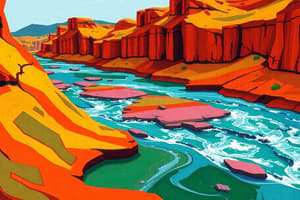Podcast
Questions and Answers
What is the process by which dissolved materials are transported by a river?
What is the process by which dissolved materials are transported by a river?
- Saltation
- Suspension
- Traction
- Solution (correct)
What is the primary cause of the formation of meanders in a river?
What is the primary cause of the formation of meanders in a river?
- Vertical erosion
- Hydraulic action
- Attrition
- Lateral erosion and deposition (correct)
Which landform is formed by the retreat of a waterfall upstream?
Which landform is formed by the retreat of a waterfall upstream?
- Oxbow lake
- V-shaped valley
- Gorge (correct)
- Interlocking spur
What is the difference between a watershed and a tributary?
What is the difference between a watershed and a tributary?
Which of these processes is NOT involved in river erosion?
Which of these processes is NOT involved in river erosion?
What is the main difference between saltation and suspension?
What is the main difference between saltation and suspension?
What is the primary reason for the formation of an oxbow lake?
What is the primary reason for the formation of an oxbow lake?
Which of these is NOT a characteristic of a river's upper course?
Which of these is NOT a characteristic of a river's upper course?
Which of the following is NOT a strategy for flood management?
Which of the following is NOT a strategy for flood management?
What is the main purpose of widening and deepening the river channel as a flood management strategy?
What is the main purpose of widening and deepening the river channel as a flood management strategy?
Which of the following is NOT a landform created by river deposition?
Which of the following is NOT a landform created by river deposition?
What is the role of levees in preventing flooding?
What is the role of levees in preventing flooding?
Which of the following statements accurately describes the role of floods in terms of soil fertility?
Which of the following statements accurately describes the role of floods in terms of soil fertility?
Flashcards
Floodplains
Floodplains
Wide, flat areas on either side of a river formed by flood deposition.
Levees
Levees
Natural embankments of sediment along river edges formed during floods.
Deltas
Deltas
Landforms created when rivers deposit sediment at slower water bodies.
Flood
Flood
Signup and view all the flashcards
Flood Management Strategies
Flood Management Strategies
Signup and view all the flashcards
River Definition
River Definition
Signup and view all the flashcards
Drainage Basin
Drainage Basin
Signup and view all the flashcards
Watershed
Watershed
Signup and view all the flashcards
Erosion in Rivers
Erosion in Rivers
Signup and view all the flashcards
Hydraulic Action
Hydraulic Action
Signup and view all the flashcards
Meanders
Meanders
Signup and view all the flashcards
Oxbow Lakes
Oxbow Lakes
Signup and view all the flashcards
River Mouth
River Mouth
Signup and view all the flashcards
Study Notes
Rivers: Introduction
- Rivers are natural watercourses flowing from higher to lower ground, ultimately reaching a larger body of water (sea, lake, or another river).
- Rivers play essential roles in shaping landscapes, providing water for ecosystems, agriculture, consumption, and transportation.
Drainage Basins
- A drainage basin is the area of land drained by a river and its tributaries.
- Key features include watersheds (boundaries between basins), sources (often in highlands), tributaries (smaller rivers joining a larger one), confluences (where rivers meet), and mouths (where the river enters another body of water).
River Processes
- Erosion: Rivers erode landscapes through several processes:
- Hydraulic action: Water force erodes the riverbed and banks.
- Abrasion: Carried sediment wears down riverbed and banks.
- Attrition: Sediment collides, becoming smaller and smoother.
- Solution: Soluble materials dissolve in water.
- Transportation: Rivers transport sediment in various ways:
- Traction: Large materials are rolled along the riverbed.
- Saltation: Smaller stones bounce along the riverbed.
- Suspension: Fine particles are carried within the water.
- Solution: Dissolved materials are invisible in the water.
- Deposition: Occurs when a river loses energy and drops its load, typically in slower-moving areas.
River Landforms (Upper Course)
- V-shaped valleys: Formed by downward erosion.
- Interlocking spurs: Hills protruding into valleys.
- Waterfalls: Formed by flowing over hard rock layers above softer rock.
- Gorges: Steep-sided valleys resulting from retreating waterfalls.
Meanders and Oxbow Lakes
- Meanders: Large bends in the river, formed by lateral erosion and deposition.
- Erosion occurs on the outer bank (faster current).
- Deposition occurs on the inner bank (slower current).
- Oxbow lakes: Horseshoe-shaped lakes formed when a meander is cut off.
River Landforms (Lower Course)
- Floodplains: Wide, flat areas along the river, formed by flood deposits.
- Levees: Raised banks of sediment deposited during floods.
- Deltas: Landforms formed by river deposition at the mouth, entering a slower body of water.
Floods
- Floods occur when rivers overflow their banks, caused by heavy rain, rapid snowmelt, or human impacts.
- Floods can damage properties and infrastructure. However, they can also deliver nutrients to floodplains, enriching soil.
Flood Management Strategies
- Bypass: Diverts water from urban areas.
- Channel widening/deepening: Increases water capacity.
- Raising car parks: Prevents flooding.
- Higher bridges: Allows water flow beneath.
- Tree management: Prevents obstructions.
Studying That Suits You
Use AI to generate personalized quizzes and flashcards to suit your learning preferences.




